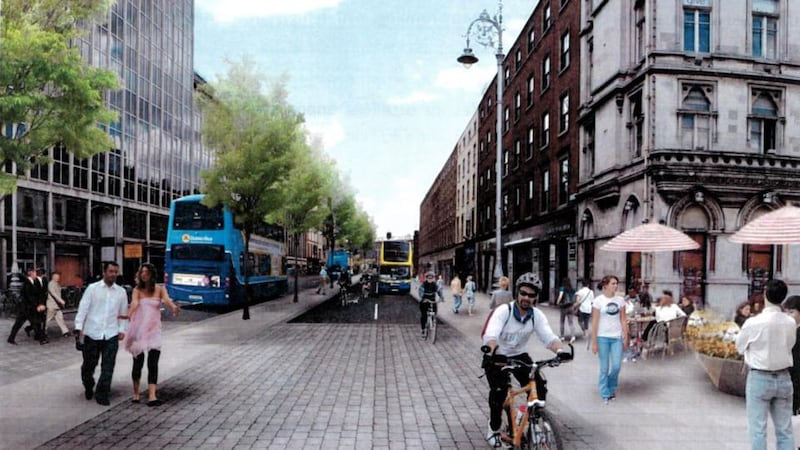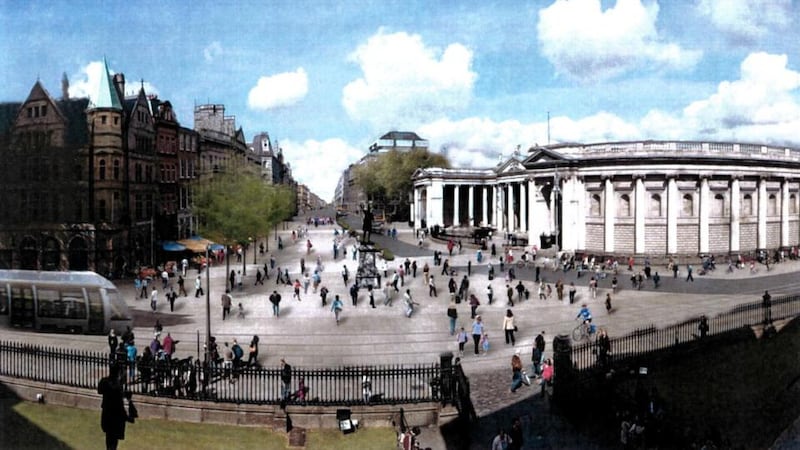The most comprehensive assessment yet of traffic in Dublin city centre has concluded that most of it should go elsewhere. And the picture painted by the National Transport Authority (NTA) of the current state of play is far from flattering. In fact, it portrays a shambles.
College Green is plagued by "bus congestion, overcrowded bus stops and cluttered narrow footpaths", while on Westmoreland Street pedestrians are "confined to a relatively narrow area containing trees, phone boxes, side-road entrances, front-of-shop promotions etc".
Comfort and space
With work already under way on the Luas Cross City line that will run through College Green, the NTA sees this project as an opportunity to transform the public realm to "allow people to enjoy some of the best of Dublin's architectural heritage in comfort and space".


Its draft City Centre Transport Assessment Study, seen by The Irish Times, proposes that traffic would be excluded from College Green, with the southern half turned into a pedestrian plaza and bus-only lanes in either direction on its north side.
Due to the "permanent removal of general traffic" from College Green, it would be possible to accommodate the movement of buses by "converting the two inbound traffic lanes beside the Bank of Ireland building . . . into a two-way bus street", it says.
“One of the proposed changes at College Green is that the existing peak-hour bus gate time periods will be extended to facilitate both the construction and the operation of Luas Cross City,” the NTA says. At present, the “bus gate” only operates at peak times.
Wider footpaths
The study also favours pedestrianisation of Suffolk Street and Church Lane, the removal of traffic from Westmoreland Street, enabling its footpaths to be widened considerably, as well as making D'Olier Street, Beresford Place and Winetavern Street two-way.
If the proposals are adopted, Westmoreland Street will cater for the “limited number of buses that co-run with Luas Cross City” and a two-way cycle route. “The vast majority of the street space will be given over to providing a high-quality pedestrian environment.”
D’Olier Street is identified in the study as a potential two-way street, with a high concentration of bus stops in each direction, which would help to enliven it on both sides. It would have a new central median, similar to O’Connell Street although not quite so wide.
Christchurch Place would become a "pedestrian-friendly space" with just one lane of traffic in each direction, so that some of Dublin's premier tourist attractions – notably Christ Church Cathedral – could be seen in "an attractive environment with minimal traffic intrusion".
The study also proposes an extensive city centre cycle network, giving cyclists “defined routes . . . to traverse and access the city centre with minimal conflict with other road users” – in recognition of a 40 per cent rise in cycling commuters between 2006 and 2011.
The key to delivering major benefits for pedestrians, cyclists and public transport users in the city centre would be a defined “orbital route” taking through-traffic out of the city centre, with 15 “gateways” allowing access to different quadrants of the core area.
Busáras simplified
This would be facilitated, for example, by making Beresford Place and Matt Talbot Bridge two-way, thereby providing a more direct route for north/south traffic in both directions. This would also eliminate the need for buses using Busáras to circle the building.
Northbound traffic would be “displaced” from Tara Street to Moss Street, providing a direct route outbound via the Matt Talbot Bridge and Memorial Road for traffic heading to the north side.
The Samuel Beckett Bridge would also cater for extraneous traffic.
Traffic circuses such as Beresford Place and Kelly’s Corner – known as “gyratories” in road-engineering-speak – would be eliminated under the NTA’s proposals and replaced with two-way streets (the latter to facilitate turns on the orbital route).
Westland Row would become a “public-transport-only corridor” with a much wider footpath on its eastern side to cater for the many commuters using Pearse station.
A new off-street coach-parking facility would replace coaches lined up in Nassau Street.
Overall, the changes being proposed would obviously have major implications for the city. The NTA would have preferred the draft study to be kept confidential, fearing that publication would lead to lobbying and that the final plan could be compromised as a result.
Rule of traffic
There have been other plans drawn up in the past that weren't implemented for one reason or another – mainly lack of funding. In some cases, where the priority was to cater for rather than manage the traffic, the city is better off as a result – even as things stand.
But the NTA’s study takes a different tack – prioritising pedestrians, cyclists and public transport users. It holds out a vision of what the centre of Dublin could be like – in place of the current shambles, however “normal” that may seem to many of the citizens.









